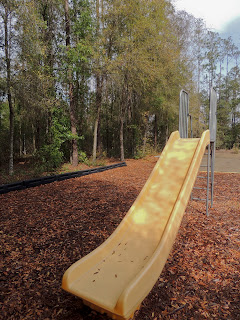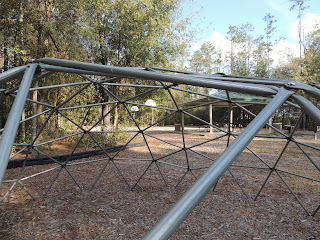The
Environmental Protection Agency defines environmental
justice as “the fair treatment and meaningful involvement of all people
regardless of race, color, national origin, or income with respect to the
development, implementation, and enforcement of environmental laws,
regulations, and policies.” It only takes a short walk to realize this has not
been the case in South Apopka.
In
this instance, a sign of environmental injustice
is a disproportionately large number of hazardous, toxic, or polluting sites
within a concentrated area in close proximity to neighborhoods of substandard
housing. When I learned there was a medical waste incinerator right next to a
playground in Apopka, I knew that something suspicious had happened. It was not
until two years later after first learning of this space that I finally had the
opportunity to investigate further.
The
total area depicted in this series fits within a radius of a quarter mile.
Eight of the fourteen images were taken from the playground itself, which Waste
Management agreed to build as part of the deal to open a second landfill. It
was often difficult to get a good view of the Stericycle medical waste
incinerator and two landfills. Overgrown brush and a few thorny vines buffering
the fences shield the back view of the
facilities. A variety of no trespassing
signs on the front make it clear that people are not welcome. Once, when I was
taking photographs in front of Stericycle, a truck driver exiting the gate
stepped out of his 18-weeler and said, “I see you’re taking pictures, what’s it
for?” After I informed him of the academic nature of my project, he replied,
“You know we don’t want that.” I waited for him to drive away and continued
taking pictures while I myself was in view of the facility’s security cameras.
Whether
I was under video surveillance, trekking through thorny brush, or peering
through fences, the sense of unease permeated the site, which was made palpable
by the sounds and smells suggested in the pictures, but visibly absent. I could hear the hum of the incinerator as it
was in operation, probably spewing out a variety of neurotoxins when I was next
door in the playground. After a bit of rain, there’s a pungent smell of what I
can only describe as barbequed garbage. Local residents have also raised
complaints about the smell of methane that creeps into their houses in the
morning, but Waste Management officials say the source of the odor is from a
sewage treatment plant across the other side of the neighborhood. With so many sites spewing pollution, accountability
is difficult to come by since everyone can point their fingers at everyone
else. I felt simultaneously sneaky and unsettled while taking these
photographs, a feeling which I intended to convey in this series. Although,
when I was done, I could leave. Many people live around here, and this is only
one place of thousands with a similar story.

































